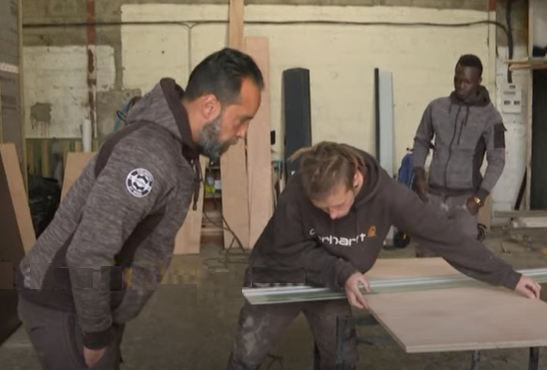France is famous for its craftsmen skills used in crafting iconic buildings. The Arc de Triomphe, Eiffel Tower and Notre Dame cathedral are all rightly famous world-wide. But in a quiet corner of Brittany, a housing charity is creating its own small achievements using homeless builders. By James Teo.
Séné, Brittany, France.. May 2022. “At AMISEP we run this project that helps us build mobile (tiny) homes and helps homeless people too,” says tiny home project co-ordinator Simon Robitaille. “We ensure that the future inhabitants of the houses (we build) are deeply involved in the construction phase of the homes, from the framework to the walls right through to the interior fittings.”
“Our tiny homes help homeless people too” - Simon Robitaille, AMISEP
Robitaille says the project is the perfect response to issues that affect local people who have fallen on hard times, may have social problems, or just find themselves with anywhere to live for some reasons. It not only provides mobile, easily sited tiny homes that offer basic amenities and security, but is also responding to demand for small-scale housing units for sole inhabitants.
"Here in the (Breton) Gulf of Morbihan, we have a lot of difficulties finding small housing at realistic rates for people who are on social minima, who work on temporary contracts, who only have part-time jobs, things like that," he explains.
The project is designed to offer people in precarious positions not only a place to live and call their own, but also gain practical experience in design, construction and fitting-out techniques – skills they can then use to seek more permanent or better-paying jobs.
“Our approach can benefit people like asylum seekers, homeless people, or people in unemployment. It offers an opportunity for very desocialised or marginalised people to own the homes they live in,” smiles Robitaille. "The idea was to combine housing with a useful on-site activity. So we started this original idea of self-building tiny houses".
“It keeps me busy, it does me good” - Mahono Coulibaly
AMISEP is careful to match its budding builders to work they can handle and benefit from, says technical director Bastien Gohier. “We evaluate each person to see what there are skills and to establish where and what they feel most comfortable doing," he explains. "Then we divide the tasks to (the clients) according to each person's abilities."
For the participants, the fact the homes are not just hand-outs – they have a vested interest in building them properly as they will have to put up with the problems if they don’t – but are built for themselves carries considerable weight with the scheme’s participants.
"It's important (building my home myself),” explains Mahono Coulibaly from Mali. Coulibaly is an asylum seeker who is waiting to hear if his claim for asylum will be granted. Until then, he is in something of a limbo.
“I don't really have much I can or want to do. So I come here (to the AMISEP project) to keep myself busy. It does me good, and makes me happy to be able to participate in the atmosphere here. I really enjoy it,” he says.
The workers gain valuable skills as well as somewhere to live. Courtesy AMISEP.
It’s not a ‘proper job’ but most of the workers love it. "Some are here every day, others come once and never come back,” says Robitaille. “It's a system that can welcome people who don't find their place anywhere else." And when the tiny houses are finished, selected construction workers get their own keys; the house is theirs.
"Freedom!" says previously homeless Pascal, one of the tiny housebuilders. He waves the keys of his new house on wheels; as an unemployed 52-year old, the options of finding a decent home were distinctly limited until he signed up with AMISEP.
"It's perfect. I've lived in a caravan before, and this is way better," he says as he walks around his 20sq.m home complete with shower, toilet, kitchen, sleep area and fold-out table. "It's a total change. Here, we are more free (than in a homeless dormitory). I can step outside from my own front door."
And because his house is tiny, it has a small carbon footprint, is easy to heat, clean and keep tidy, can even be driven to a different site if Benoit gets tired of the view.
"This project is both a construction exercise but also a reconstruction exercise for the workers," says Frédéric Le Poul, AMISEP director. “The people that work (on the houses) can (more easily) get back into society as well as into a home.”



